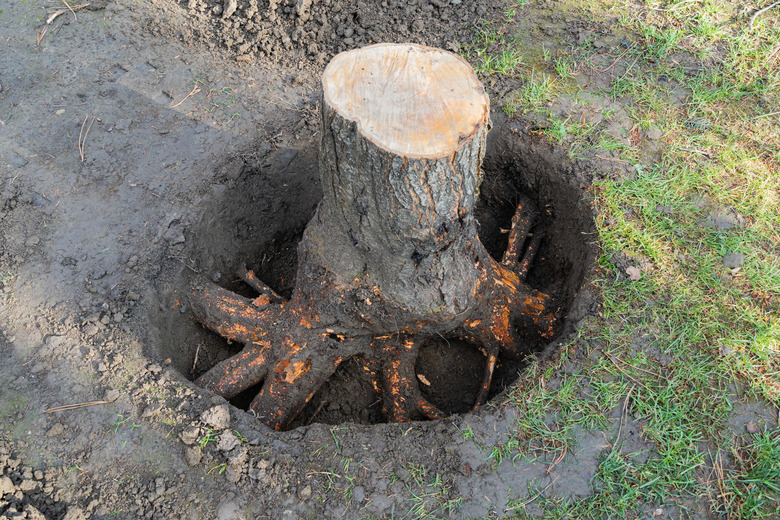How To Kill Tree Roots Naturally
We may receive a commission on purchases made from links.
If you've cut down a tree, you probably have an unsightly stump in your yard. Under that stump is a powerful network of tree roots still sucking up nutrients and moisture and preparing to fuel more growth. Or, you may have already dug out a tree stump but left some roots that are continuing to sprout.
Tried and true chemical methods for killing roots and stumps, such as treating with herbicides strong enough to kill a tree, can also impact groundwater and have other negative environmental effects. If you want to kill tree roots and stumps naturally, time is your friend, but if you don't have time, plan on some serious labor.
Killing Roots and Stumps Over Time
Killing Roots and Stumps Over Time
Two main methods can work to kill stumps and roots if you are willing to wait it out — possibly years if the roots are topped by a sizeable stump. One is girdling, and the other is to use rock salt.
Because a tree's bark is critical in the transport of nutrients and water from the roots to the upper part of the tree, the tree will die if you remove the bark. This process is called "girdling." To girdle a stump, cut the bark all around the stump in a swath at least 2 or 3 inches wide. While the cut is fresh, treat with white vinegar, which is a contact herbicide. At this point, it's a waiting game. Eventually, the roots will be deprived of nutrients and will no longer be viable.
Another method is to treat the roots or stump with rock salt. This effectively cuts off the water supply from the roots because the salt absorbs any moisture in the soil. This method is somewhat drastic, however, because it will also kill any nearby plants.
Burning Out a Stump
Burning Out a Stump
If you have retained the stump, you can burn it. This is a much faster but more time-consuming solution than girdling or rock salt. Before burning a stump, first check with your local fire department to make sure that making a fire in your yard to burn a stump is allowed.
If so, then make sure the weather and the stump itself are dry; don't try this if you have just cut down the tree. Burning doesn't necessarily burn and kill all the roots, but it will set them back enough that regrowing is highly unlikely.
Warning
Before attempting to burn a stump, take important safety precautions. These include removing any flammable materials within a 20-foot radius around the tree and making sure a hose is nearby. In addition, be prepared to attend the fire the whole time it is burning.
To set a stump on fire, some experts recommend drilling holes into the stump, pouring in some kerosene, then making a fire on top of the stump with some kindling. Other experts say to avoid using a flammable liquid due to the inherent dangers, so if you choose this method, take safety precautions; that is, keep all children and pets away, and use only kerosene and not something more flammable like gasoline.
If you choose to avoid the kerosene method, use a chainsaw to gouge some deep lines criss-cross on the top of the stump and then make the fire. Either way, keep the fire burning. If the stump doesn't burn through in one session, you might plan multiple "campfire" events in your yard and invite the neighbors. You may as well enjoy it!
Manually Removing Roots and Stumps
Manually Removing Roots and Stumps
The hardest but perhaps most surely effective method to kill roots naturally is to dig them out. If the tree isn't too large, you can do it yourself; otherwise, you'll need to hire a professional or rent a backhoe.
To manually dig out a tree and its roots, first cut down the tree to about 3 or 4 feet tall; don't cut it all the way to the ground because that will deprive you of purchase when you want to pull out the stump. Start with a shovel and a pickaxe, digging a wide circle around the tree to begin to expose and loosen the roots. As the roots are exposed, cut them with a chainsaw, hatchet, or garden saw. As you remove the larger roots, you can cut out the smaller roots with clippers or loppers.
To remove the stump, rock it back and forth to identify where roots are still connected. Once all the roots are severed, pull out the stump. At that point, to ensure that you get all the viable roots, dig around the loosened dirt and remove any other roots with any girth.
